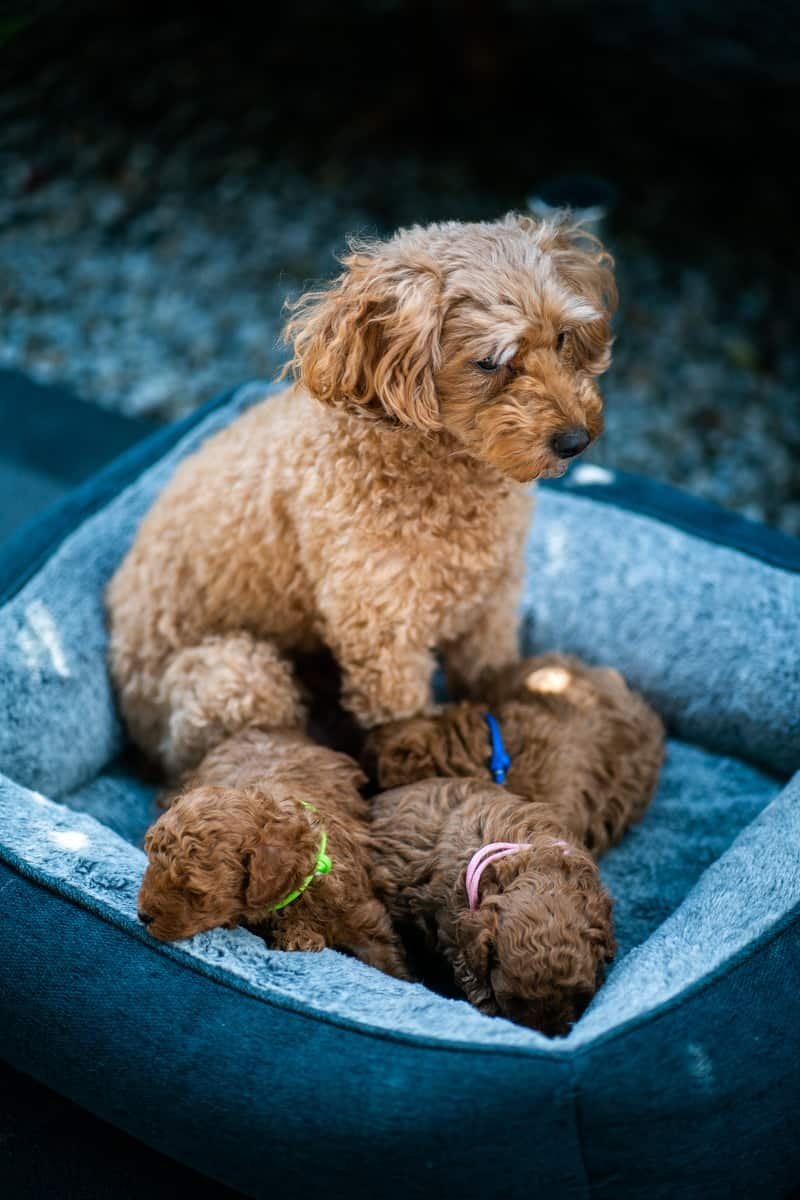
If your Poodle is expecting, then congratulations! Soon, you’ll become a proud owner of a beautiful litter of puppies. As you take care of the mother Poodle, you’re probably wondering about what to expect, particularly the average litter sizes.
While you can verify how many male and female poodle puppies via ultrasound during a vet visit, it’s still worth knowing the average litter sizes of the different Poodle types.
Factors Affecting the Average Size Litter
Before we talk about the average litter size per Poodle variety, it’s essential to note that the number can increase or decrease. Various factors are affecting the number of puppies born in every litter. Such factors fall around the genetics of the litter’s parents’ dogs and the environment during the pregnancy.
After all, a healthy and happy dog will most likely to give birth to more healthy puppies when surrounded by lots of love, care, and peace.
Breeder
The breeder you choose would increase the chance of your dog or puppy living a healthy life. It’s essential to research the breeder before letting them breed your dog or purchasing a Poodle puppy.
Breeders are in charge of the factors we’ll mention below with coupling the Poodle breed, including the mother, father, breeding process, and environment throughout the pregnancy and birth.
Timing
When dogs are in heat, it’s the optimum time to breed them. Most dogs would go into heat around twice a year, lasting for a week. But breeding Poodles is more than putting female dogs in the heat with a male dog, waiting for nature to do its thing.
The process of dogs coupling would affect the number of puppies.
During a dog’s heat cycle, there are certain days where she’s more fertile than other days of the week. If the male and female Poodle can come together successfully during that period, there’s a higher chance of a larger litter. It’s why some breeders are breeding Poodles multiple times over the week, increasing the chances of successful conception.
Age
The Poodle mother’s age is an essential factor in her puppies’ health. Most dogs must only breed for 3-4 times, and it shouldn’t be within the parent’s first two heats. The ideal age for Poodle mothers is 2-4 years old.
The same would go for the father’s dog. The older the father Poodle is, the riskier the puppies’ health may be. Dogs are less fertile as they become older, as humans. While male dogs can father puppies regardless of their age, they have a safer and more reliable seed within 2-7 years old.
Health
The parent Poodles’s health is also a considerable aspect of the puppies’ health. Health will also affect the number of puppies in a litter and the litters a dog can have.
Some Poodles may not handle pregnancy and others can, with some dogs only having 2-3 litters.
The father’s health would also impact the health and number of puppies per litter. A healthy sire would decrease pregnancy and birth risks.
As you can see, the healthier the dogs, the more puppies they can have. Professional breeders are aware of this, which is why they pair dams and sires based on age, genetics, health, and even personalities.
Genetics
The parent dogs’ genetics play a massive role in how many pups per litter you’ll receive, along with their overall health. Reputable American Poodle breeders would run multiple genetic tests on their dogs to ensure no congenital and genetic defects or any negative tendencies. Breeders may also run tests for ancestries and potential fur colors.
Good genetics won’t only increase the chance of healthy litters, but it can show whether you can expect a smaller or larger litter size. Healthier female Poodles may have more puppies and litters with fewer health risks.
The Season
Yes, even the time of the year would impact the litter size. Reputable breeders and experts aren’t sure of the exact reasons, but Poodles have larger litters come springtime than fall and winter. It’s a mysterious phenomenon, but one that continues every year.
So if your Poodle will go into heat for winter litter, you may have to expect fewer puppies per litter compared to spring and summer.
Besides that, a poodle mother’s first birth would usually result in fewer puppies. For instance, Standard Poodles would have around 3-5 puppies during the first birth rather than seven puppies as expected.
With that in mind, let’s look at the average size litter, depending on the Poodles. Here are the popular Poodle varieties:
Standard Poodle Litter
Standard Poodles are the largest among the three official Poodle varieties. This type of Poodle can weigh up to 70 pounds, measuring 15-18 inches tall. You can find King and Royal Poodles above the height and weight range, growing up to 90 pounds!
Standard Poodles have the largest litters among the three, usually giving birth to seven pups per litter. The largest litter comes from a Standard Poodle mom from Canada, giving birth to a whopping 16 puppies!
The average size litter will also depend on the mother’s body size. Biologically, bigger bodies can carry larger litter sizes than smaller ones.
Miniature Poodle Litter
Miniature Poodles are a tad smaller than Standard Poodles, weighing between 12-17 pounds and measuring 11-15 inches tall.
This type of Poodle would have about five puppies per litter, though it can vary based on the factors mentioned above.
Toy Poodle Litter
Toy Poodles are the smallest among the different Poodles mentioned and one of the cutest canine companions. Adult Toy Poodles would weigh between 5-10 pounds and measure less than 10 inches tall. These dogs also have the longest life expectancy of up to 18 years.
As expected, the smallest poodle variety would have the smallest litter sizes. Toy Poodles’ normal puppy litter size is three puppies, though it may change given the mother’s and breeding circumstances. Some mothers may give birth to a single puppy, while others give birth to five puppies, though the latter is rare.
Toy Poodles are in high demand, but they are more expensive than other Poodles because of their smaller litter size. Contact your breeder to secure a Toy Poodle puppy!
How Many Litters Can Poodles Have?
Whether you own a Standard Poodle, Miniature Poodle, or Toy Poodle, they should not breed for over five times at most. Over five litters may hurt a female dog. It can also increase the chance of post-birth injury and unhealthy puppies.
But if you make sure you care for your Poodle well and that she’s in healthy shape, then she can breed up to five times with minimal risk. Also, regardless of how old your female is, never keep her breeding after 4-5 litters. For Miniature or Toy Poodles, keep it to four litters, as they have fragile bodies sensitive to pregnancy.
That said, the mother of Poodle’s age and health can cut her breeding years short. It’s vital to ensure that you have a happy and healthy breeder Poodle after each litter.
How to Care for a Pregnant Poodle
If you have a pregnant dog expecting a Poodle puppy, the care requirements can change up a bit! We share some great tips for caring for your pregnant Poodle for a successful pregnancy and birth.
Give your dog moderate exercise daily, continuing the usual routine without intense activities. That way, your pregnant Poodle can maintain muscle mass while keeping her body in the best shape as she prepares for birth.
Your pregnant Poodle’s appetite will increase during the second to the third week, with her nutritional needs almost doubling by the fifth week. Feed your dog a well-balanced and protein-rich diet, maybe even adding one egg and one to two scoops of cottage cheese for protein. Your female dog will have an ample diet during this period and while you should not deprive her of meals, make sure you feed her healthy food!
Do not give your pregnant dog calcium supplements, as this can cause issues in your adult Poodle.
Allow your mother to Poodle to rest as much as she needs to, giving her a peaceful and noise-free home.
Don’t forget to care for your Poodle’s hypoallergenic coat! Continue brushing your dog’s adult coat daily and giving it baths whenever needed.
Expect the pregnant Poodle to gain about 25-30% of her ideal weight by when she’s ready to give birth.
Bring your dog to the veterinarian for routine check-ups. Also, study the different stages of labor and how your dog can have a successful pregnancy, so you’re prepared for what’s to come ahead!

